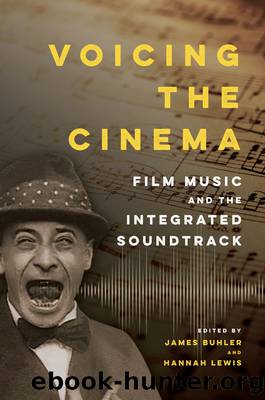Voicing the Cinema by James Buhler; Hannah Lewis

Author:James Buhler; Hannah Lewis
Language: eng
Format: epub
ISBN: 9780252051869
Publisher: University of Illinois Press
Published: 2020-08-15T00:00:00+00:00
Vocal Support: Constructing Composersâ Voices, on and off the Screen
Felix and Mickeyâs fictional compositions had to be written by real-life musicians. One irony of the Four Daughters production is that the sole credited composer, Max Steiner, wrote neither. Felixâs pieceâwhich is only heard in part during scenes of Felix and Mickey at the pianoâwas written by Heinz Roemheld, a prolific film composer who later assisted Steiner on Gone with the Wind (1939).13 Roemheldâs stylistic direction came from the script. One draft describes Dietz as âa composer of music of the Gershwin type. Possessor of a personality that makes it perfectly feasible that all four sisters should fall in love with him.â14 Roemheld provided a 44-measure piano piece aptly titled âRhapsody.â15 A swooning legato line opens the work and is highly reminiscent of the so-called âlove themeâ from Gershwinâs Rhapsody in Blue, both of which feature a plunging downward leap of an octave. (See Examples 8.1 and 8.2.) Roemheld also incorporates blue notes, colorful harmonic substitutions, and swung rhythms in the accompaniment to make the work redolent of Gershwinâs jazz gestures in his symphonic works. Although Roemheld wrote a contrasting scherzolike section for Felixâs âRhapsody,â it is not used in the film. The opening idea, however, plays throughout the filmâs main titles. When the sequel films reused this theme in their main title sequences, the melody became the calling card of the Four Daughters series.
Mickeyâs âmiddleâ was composed by pianist Max Rabinowitsch.16 Hailed by critic Isabel Morse Jones as an âaccompanying geniusâ who âadds distinction to the music life of Los Angeles,â Rabinowitsch had played in recitals with singer Fyodor Chaliapin, violinist Nathan Milstein, and actress Doris Kenyon.17 He also regularly performed in studio orchestras for films. For Four Daughters, Rabinowitsch helped train the actors to mimic performances on musical instruments and arranged music recordings for on-set playback during production.18 Rabinowitsch playfully dedicated Mickeyâs âmiddleâ to âHula Boy Max Steiner,â who, in a rare departure from his workaholic regime, had indulged in a vacation to Hawaii.19 In his annotated copy of the script, Rabinowitsch evinces pride for his contribution to the filmâs original music. At the moment in the script where Rabinowitsch planned to have Mickey play the piece that captures Annâs interest, Rabinowitsch writes in the margin âHe starts to play my composition.â20 Rabinowitschâs opus is only 21 measures long and offers two varied repetitions of a six-measure idea. The spirit of Gershwin may be detected in this theme as well. There are again resemblances to the love theme from Rhapsody in Blue (including a shared key), although Rabinowitschâs model is appropriately the âmiddleâ of that theme.21 Not surprisingly, Rabinowitschâs full piece sounds incomplete. (See Examples 8.3 and 8.4.)
Download
This site does not store any files on its server. We only index and link to content provided by other sites. Please contact the content providers to delete copyright contents if any and email us, we'll remove relevant links or contents immediately.
The Kite Runner by Khaled Hosseini(4941)
Gerald's Game by Stephen King(4357)
Dialogue by Robert McKee(4148)
The Perils of Being Moderately Famous by Soha Ali Khan(4058)
Story: Substance, Structure, Style and the Principles of Screenwriting by Robert McKee(3323)
The 101 Dalmatians by Dodie Smith(3290)
The Pixar Touch by David A. Price(3195)
Confessions of a Video Vixen by Karrine Steffans(3095)
How Music Works by David Byrne(2950)
Fantastic Beasts: The Crimes of Grindelwald by J. K. Rowling(2836)
Harry Potter 4 - Harry Potter and The Goblet of Fire by J.K.Rowling(2791)
Slugfest by Reed Tucker(2784)
The Mental Game of Writing: How to Overcome Obstacles, Stay Creative and Productive, and Free Your Mind for Success by James Scott Bell(2755)
4 - Harry Potter and the Goblet of Fire by J.K. Rowling(2519)
Screenplay: The Foundations of Screenwriting by Syd Field(2424)
Scandals of Classic Hollywood: Sex, Deviance, and Drama from the Golden Age of American Cinema by Anne Helen Petersen(2390)
Wildflower by Drew Barrymore(2377)
The Complete H. P. Lovecraft Reader by H.P. Lovecraft(2364)
Casting Might-Have-Beens: A Film by Film Directory of Actors Considered for Roles Given to Others by Mell Eila(2294)
